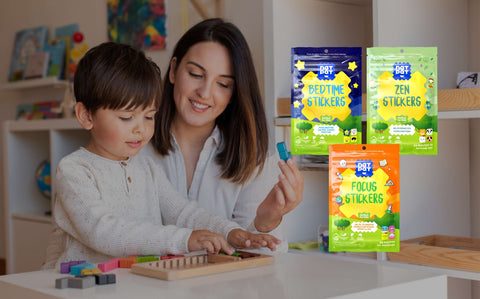As we get older, we learn how to manage our emotions better. Things frustrate or excite us, and instead of becoming overwhelmed, we have tools and steps in place to help us soothe our dysregulation. However, this social skill isn’t easily mastered the first time (or 20).
As such, children may have a hard time dealing with their own emotions and using their self-regulation skills.
Now, those steps and tools are in place, thanks to our past experiences. As parents, we are now the ones in charge of putting those steps into place for our little ones.
So today, we are going to go over emotions, the ideas behind what it means to manage emotions, and what the emotional ranges should be for specific child age groups. Then we will get into the top ten tips on how to effectively help your kiddos manage their emotions and keep the harmony in the home.
Understanding Emotions
First of all, what are emotions?
Emotions are human reactions that are responses to experiences and events. Different types of events, in varying degrees of circumstances, will trigger different responses from each and every one of us.
We all have a basic set of emotions like happy, sad, and angry. But then there are deeper responses that can be more personal and unique to each individual.
Managing Emotions
As adolescents, we learn the tips and tricks to help us understand, identify, and compartmentalize our emotions. Being able to do so makes it easier as adults to understand experiences and react appropriately.
But as children, reactions are age-appropriate as well as appropriate to relatable experiences. As we age, we learn coping skills for situations that we face. When we face them again, we are more prepared.
Managing emotions isn’t about suppressing feelings but rather understanding feelings and using them to relay and express your thoughts. Those big feelings of our toddler years would be much harder to cope with in adulthood without a bit of practice.
Emotions by Age Group
For parents, it’s easier for us to discuss these tips through the lens of each stage of child development. Breaking down kids into three categories: toddlers, young children, and pre-teens to teens will let you know where you fall right now on the emotional journey.
Toddlers (Under 3)
When kids are three and under, the key is to get them to understand the words you use for emotions. A meltdown at least once a day will be the norm as those big emotions are uncontrollable at this stage in emotional development.
Using facial signals to identify emotions will help them articulate their feelings in the future.
Young Children (3-10)
At this stage, older children are grasping the ability to identify and label their own feelings. Preschoolers are starting to be faced with difficult situations, like sharing and sitting still, and are learning appropriate ways to react.
School-age children can recognize and express their emotions through more carefully executed words and phrases and are beginning to find the emotional skills they need.
Pre-Teen and Teenagers (11-17)
Pre-teens and teens can identify what and how they’re feeling, but they still need to find the skills to process emotions and responses.
During this stage in development, situations and experiences are more intense and individualized. This means that reactions can be strong, and emotions can feel big like they did when our children were really little.
We might not expect tantrums, but the occasional meltdown isn’t out of the realm of possibility.
10 Tips for Managing Emotions
Emotional roadblocks and intense feelings can happen at any age, meaning these tips for managing emotions can apply to any child. Skills look different between older and younger kids, but they aren’t impossible to start in toddler years and develop through teenage ones.
Create Coping Strategies
If your child is worried about an upcoming event or over-excited about something that just occurred, parents might perceive a wide range of responses.
Talk these emotions out and identify places where they could manage emotions differently next time. For example, if they’re stressed about an upcoming activity, talk about what’s worrying them about that specific situation and ways to handle the hypotheticals.
Practice Breathing Exercises
Taking deep breaths to manage stress or excitement can help kids calm down effectively in a short amount of time. Have them close their eyes and count their breaths rather than focus energy on the situation.
Practicing this type of self-control over their bodies will give them the confidence to manage their emotional responses better as they age and develop.
Read Emotion-Themed Books
Relating your personal experiences to characters in your favorite books is one of the reasons we love certain books so much. With kids, pick books with characters who go through emotional journeys or adventures to allow your child the experience of all those feelings through a secondary source.
They’ll get tips and social cues they might have otherwise not seen and gain some insight into emotional experiences along the way.
Walk Kids Through Your Distress Tolerance Skills
As parents, we have a lot going on, and we may forget how hard it can be to be a kid. One great way to relate to those little ones, especially those that aren’t so little anymore, is through relatable experiences.
If you’re having a rough day, talk it through with your kiddos. Let them see that sometimes your emotions are overwhelming, and just like them, you have to practice good self-control.
Take an Emotional Time-Out
A time-out is always seen as a negative thing, but time-outs can be really useful for kiddos that just need a break. Taking a minute to yourself to calm down and put the situation into perspective is great for your mental health.
If kids can learn when they’re young that it’s ok to remove themselves from situations to regain emotional control, then they will have better boundaries for their well-being as adults.
Give Praise
Getting a handle on emotional responses is a lot of work, so when your kids do it well, give them praise. This doesn’t mean chastising them when they do have meltdowns, but pointing out the times they go above and beyond for their emotional growth will help them clear up questions about what appropriate responses look like. Validate their struggles, too — balance is key.
Add to Your Self-Regulations Skills Toolbelt
Kids feel all the emotions of adults without the proper tools to regulate them. While your kiddos are learning how to manage their emotions, try our ZenPatch. It’s designed to leave you and your little ones with a calm mind and clear head.
This will go a long way in keeping your kids aware of their feelings and calm enough to manage their reactions to activities and experiences.
Identify and Avoid Triggers
Knowing your limits is a good thing, and avoiding situations that cause chaos in your mind is healthy for your mental state. While kids can’t avoid certain situations like homework or chores (no matter how much they beg), you can avoid emotional triggers that will throw off their day.
Setting boundaries for themselves will have them maintain healthy relationships as adults and encourage them to say no when things are too emotionally strenuous. For example, if they think a movie might be too scary or the child down the street isn’t a kind playmate, these are situations that can be avoided in a healthy manner.
Encourage Forgiveness of Themselves
We all lose control, and for kids, this will often happen on their road to emotional development. But it’s important that not only do we forgive our kiddos for outbursts, but we also teach them to forgive themselves.
Talk through tantrums when they’ve calmed down and let them know that while the behavior wasn’t ideal, they can learn from this experience and move on to do things differently in the future.
Create an Emotions Gauge
An emotions gauge will work like a pain scale at the hospital. One being the least and ten being the most for feelings, it will be either low-key or intense emotions, and that will elicit different emotional responses.
When they get angry, you can ask them where they are on the gauge and then decide on a plan to work through the reaction.
When To Seek Outside Help
Pediatricians will help guide you on the emotional journey of your child, but there will be times when waiting out a stage isn’t safe.
If you notice that your child seems to be experiencing sustained distress or leaning into their emotions rather than learning to manage them, it might be time to chat with their doctor.
Can Diet Affect Emotional Health?
The short answer is yes, too much junk food can affect your health and overall mood. When our bodies don’t feel right, our minds aren’t feeling great, either. Eating a balanced diet and limiting sugary and salty snacks will get your kids better in tune with proper emotional control.
If you need a step in the right direction, try using our CravePatch. It’s a fun sticker that goes on clothes and is full of all-natural essential oils and nothing more. These oils are blended together in the perfect mix to help curb unhealthy cravings.
The Takeaway
Managing different emotions takes time and practice. If your kid is struggling, just be patient and trust their process.
The best thing we can do as parents is to encourage our kiddos to grow up healthy and happy.
Sources:
Emotions and Types of Emotional Responses | VeryWellMind
Social Emotional Development: Skills to Expect at Different Ages | Understood


